Earning Napoleon’s admiration: HMS Grappler 1803
A minor action off the French coast in 1803 which involved the Royal Navy brig, HMS Grappler, was to arouse the admiration of Napoleon Bonaparte himself. The story is a remarkable one.
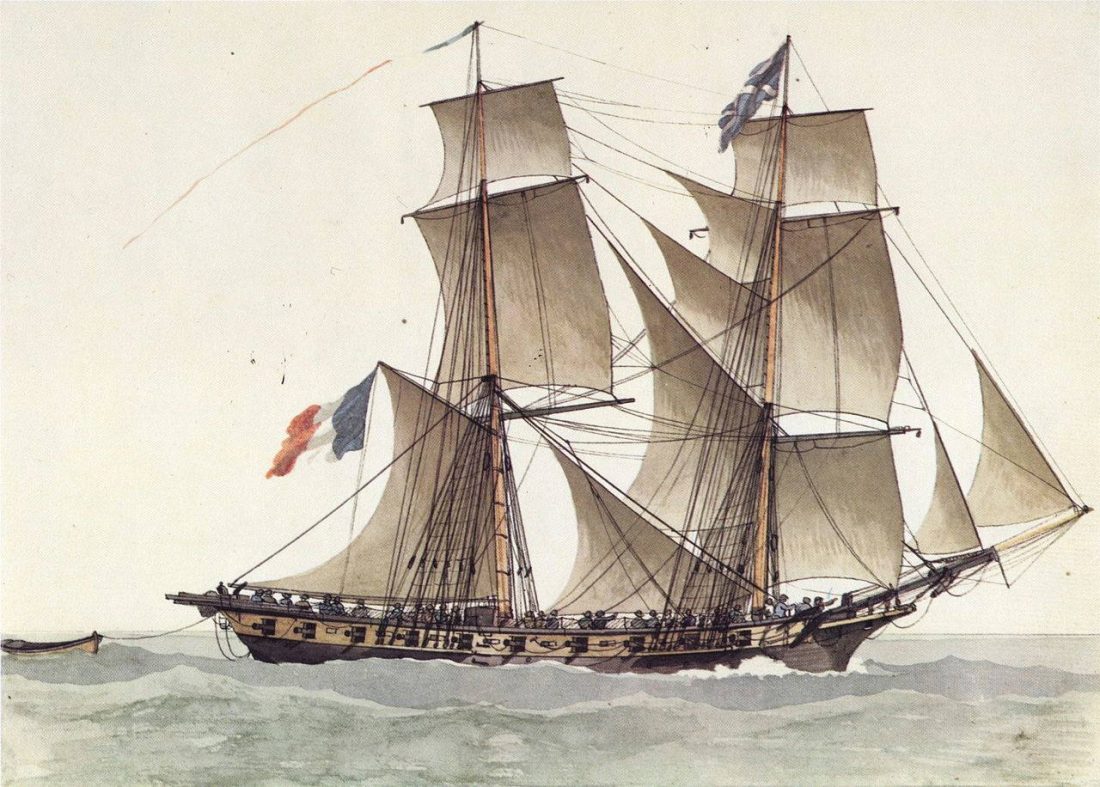
A brig-of-war – in this case French. HMS Grappler would however have looked very similar. These were very versatile craft and powerful for their size. Painting by Antoine Roux (1765–1835)
That the French never made an attempt to occupy Britain’s Channel Islands during the Revolutionary and Napoleonic Wars period, 1793-1815, is a measure of the ability of the Royal Navy to operate out of Jersey, the largest of the Channel Islands – a scant fifteen miles from the coast of Normandy – and out of the next largest, Guernsey, just thirty. This was of immense value to the effort to impose a blockade on French ports. During the preceding century, the Channel Islands and their harbours had been fortified and garrisoned. They provided useful bases, as well as sources of fresh provisions for Royal Navy vessels operating in the area.
Yet closer to the French coast, at a mere six miles, were the Chausey Isles, a scattered group of rocks twenty miles south-east of Jersey. French fortifications there had not been rebuilt in the aftermath of the Seven Years War (1756-63) and the islands were essentially uninhabited, visited only by fishermen. A few locations between the islets there did however provide emergency protected anchorages for small vessels but approaching them in safety demanded the services of an experienced pilot.
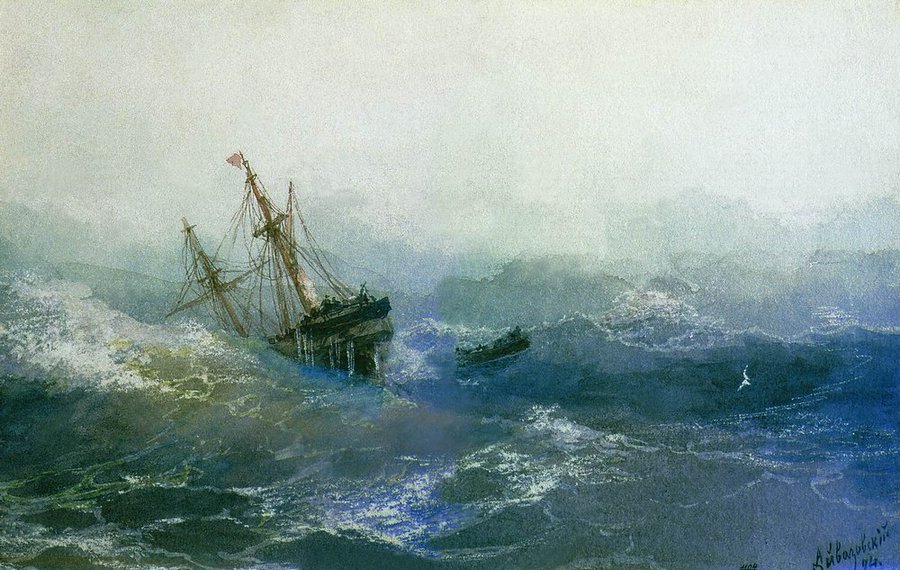
Few artists have conveyed the horror of shipwreck between rocks than Ivan Aviazovsky (1817-1900). HMS Grappler’s ordeal would have had much of this scene.
On 23rd December 1803, Admiral Sir James Saumarez, then commanding a Guernsey-based squadron of three frigates and smaller vessels, ordered HMS Grappler, a twelve-gun brig, to carry several French prisoners, two women and two old men back to France under flag of truce. The craft was commanded by a Lieutenant Abel Wontner Thomas. During the evening a heavy gale arose and Thomas decided to seek shelter among the Chausey isles. HMS Grappler’s pilot succeeded in taking her in safely but the continuing gale forced her to remain anchored – with the assistance of a cable run to a nearby rock, as well as the brig’s own anchors – for several days. The danger was of an attack from the small French port of Granville as soon as the gale died down. On 30th December the weather was at last moderating and Lieutenant Thomas, fearing the French lee shore if he continued his mission, decided to return to Guernsey. His prisoners asked to be left behind, with a small boat and six days’ provisions, so that they could make their own way to Granville.
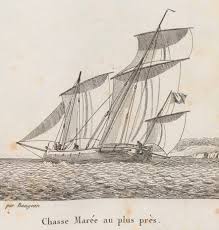
A French chasse-marée, a widely used type of fishing boat that would figure in HMS Grappler’s story
Disaster struck as HMS Grappler was getting underway. With both anchors up, and the cable attached to the rock breaking unexpectedly, the brig, out of control, was carried away by the tide. She drifted for a few hundred yards before running aground on a half-tide rock. Every effort was made to heave her off, but without effect, and as the tide fell further, HMS Grappler broke in two amidships.
Aware that the situation was probably under French observation from the mainland, and that an attack from there was now likely, Lieutenant Thomas sent his master with eight men in the brig’s cutter to Jersey to seek assistance. He was left with thirty-four men on the nearest rocks to the wreck and began to prepare a defensive position there until help arrived. Three guns were landed from the wreck to establish a battery, as well as provisions, small arms, and ammunition. While doing so, a lookout warned that several boats were approaching from shore. Lieutenant Thomas and the pilot decided they were fishing boats only, but he did not want them to get back to Granville with details of his plight. Accordingly, he went with fourteen men in a second cutter (HMS Grappler appears to have carried two) to detain the fishermen.

Chasse-marées moored at a small village
Traditional fishing boats – chasse-marées – the nearing craft might be, but when Lieutenant Thomas rounded the rocks which formed the anchorage, he found that they were full of troops. Outnumbered, he decided that his only hope of prevailing was to attack. What he had not realised as he drove forward was that other boats had already landed enemy troops and these now opened fire from the rocks above. Thomas was seriously wounded – a musket ball passed through his lower jaw and tongue. The boat’s crew now pulled for the shore, closely followed by the enemy. With their commanding officer out of action, and faced by some 160 French, his crew surrendered. The French officer in command, a Capitaine de Frégate Epiron, behaved with decency to the prisoners and in his subsequent despatch praised Lieutenant Thomas’s gallantry. Soon afterwards, Epiron was captured by the British himself, but was soon returned to France on a prisoner exchange. On arrival back he contacted Thomas, and, in the elegant language of the day, “placed his purse at Mr. Thomas’s command, with the simple understanding that he was to be repaid at the termination of that officer’s captivity.”
Napoleon himself, still “First Consul” and not yet Emperor, was so impressed by Thomas’s courage that he directed that his sword should be returned to him, and that it should be considered “a sword of honour” that he would be allowed to wear while a prisoner. This sword had apparently once belonged to Tipu Sahib, “the Tiger of Mysore.” How this came about is not clear – perhaps through another family member?
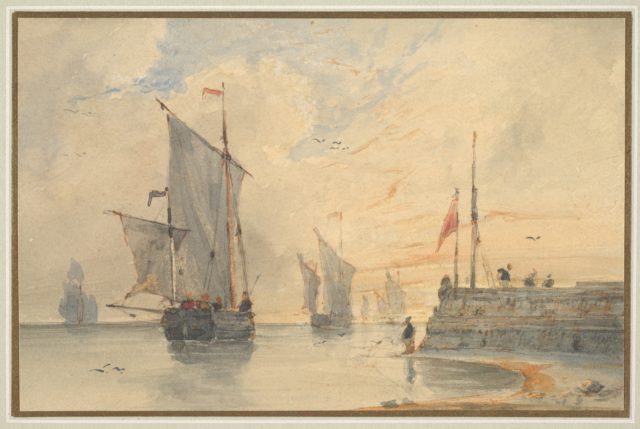
Chasse-marées at Calais, circa 1820, by Louis François Thomas Francia (1772–1839)
As soon as Admiral Saumarez learned of the fate of the Grappler, and that her commander and crew were prisoners, he sent a demand to the French for their release, on the justification that they had been sailing under a flag of truce and conveying liberated prisoners. The first impulse of the authorities at Granville seems to have been to acquiesce to this, in view of the gallantry and sufferings of Lieutenant Thomas, who was told that he would most likely be released. In Paris however, the French Minister of Marine decided that Thomas had forfeited all the protection that the laws of war afforded a flag of truce by commencing the attack on the French flotilla, instead of claiming its assistance. In strict legal terms, it is hard to disagree with this conclusion, though in view of Thomas’s ghastly wound an ex-gratia release would have been appropriate. The upshot was that he would endure ten years of weary imprisonment at Verdun, where most officer POWs were kept. This did not necessarily mean close confinement in the fortress there for, if an officer gave his word not to escape, he was allowed to reside in lodgings in the town. In Thomas’s case, he could also wear his sword of honour.
When Thomas was finally released, he had to stand court-martial for loss of HMS Grappler. He was acquitted with honour and promoted to Commander and the City of London presented him with another sword, this worth 200 guineas. He was to die in 1851, according to a Victorian source “after long years of unceasing suffering.”
It was a sad end for a gallant man, whom even Napoleon had honoured.
The latest Dawlish Chronicles novel has been published:
Britannia’s Rule
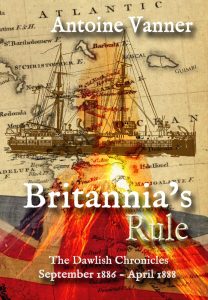 1886: Captain Nicholas Dawlish, commanding a flotilla of the Royal Navy’s latest warships, is at Trinidad when news arrives of a volcanic eruption on a West Indian island. The situation is worsening and only decisive action can avert massive loss of life. He races there with his ships to render help. His enemy will be an angry mountain, vast in its malevolent power, a challenge that no naval officer has faced before.
1886: Captain Nicholas Dawlish, commanding a flotilla of the Royal Navy’s latest warships, is at Trinidad when news arrives of a volcanic eruption on a West Indian island. The situation is worsening and only decisive action can avert massive loss of life. He races there with his ships to render help. His enemy will be an angry mountain, vast in its malevolent power, a challenge that no naval officer has faced before.
But Dawlish’s contest with the volcano is just the prelude to a longer association with the island. Its sovereignty is split – a British Crown Colony in the west, and in the east an independent republic established seven decades earlier by self-emancipated slaves. When wrenched from France through war, both seemed glittering economic prizes. Now they are impoverished backwaters where resentment seethes and old grudges fester. For many, the existence of a ‘black republic’ is resented, an affront to be excised. In France, a man of limitless ambition, backed by powerful interests, sees the turmoil as an opportunity that could bring him to absolute power. And, if he succeeds, perhaps trigger war in Europe on a scale unseen since the fall of Napoleon.
Through this maelstrom, Nicholas Dawlish must navigate a skillful course. Political concerns complicate challenges that can only be resolved by ruthless guile and calculated use of force. Lacking direct support from the Royal Navy, Dawlish must fight some of the most vicious battles of his career with inadequate resources and unlikely – and unreliable – allies.
Available in Paperback and Kindle (also readable on smartphones and tablets via Kindle App).
Kindle Unlimited Subscribers can read it, or any of the ten other Dawlish Chronicles novels, at no extra cost.
For more details and for ordering, click below:
For amazon.com For amazon.co.uk For amazon.com.au For amazon.ca
The Dawlish Chronicles – now up to eleven volumes, and with more still to come!
Click on the image below for details of the individual books
Six free short-stories are available for download to your Kindle or Smartphone. Access them by registering for the Dawlish Chronicles mailing list – just click on the banner below. You’ll be kept updated on new books and will receive other free stories at intervals.




